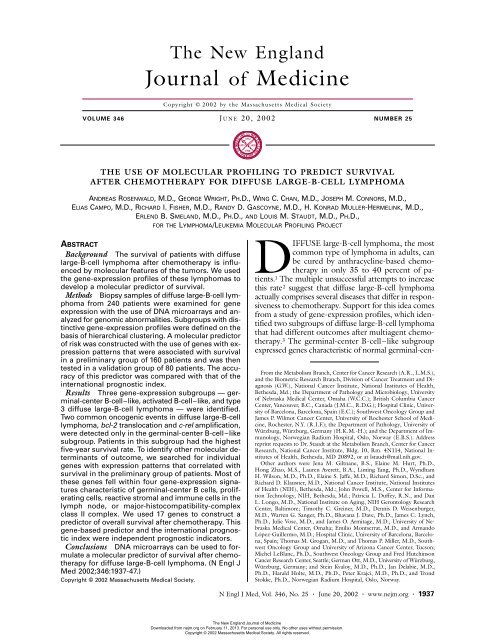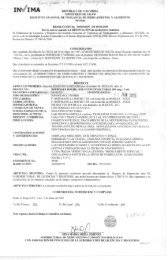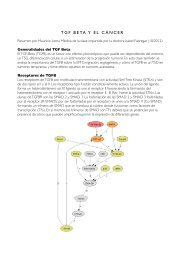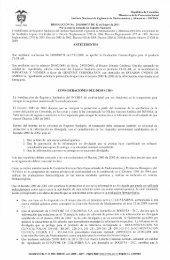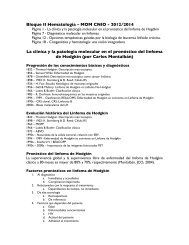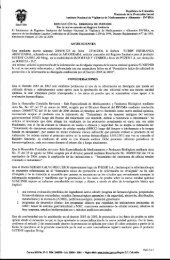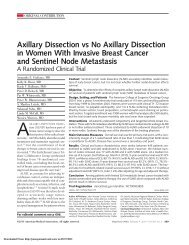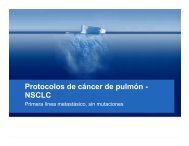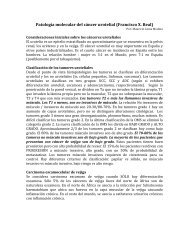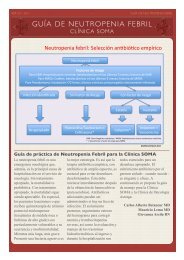DNA microarray in DLBCL
DNA microarray in DLBCL
DNA microarray in DLBCL
- No tags were found...
Create successful ePaper yourself
Turn your PDF publications into a flip-book with our unique Google optimized e-Paper software.
The New England Journal of Medic<strong>in</strong>eter B cells and were associated with a good outcome,whereas the activated B-cell–like subgroup expressedgenes characteristic of activated blood B cells and wereassociated with a poor outcome.Age, Eastern Cooperative Oncology Group(ECOG) performance status, tumor stage, lactatedehydrogenase level, and the number of sites of extranodaldisease also have prognostic value <strong>in</strong> diffuselarge-B-cell lymphoma, and they are <strong>in</strong>cluded <strong>in</strong> the<strong>in</strong>ternational prognostic <strong>in</strong>dex. 4 Although the <strong>in</strong>dexis of value, it has not been used successfully to stratifypatients for therapeutic trials. 5We hypothesized that gene-expression profiles ofdiffuse large-B-cell lymphoma could be used <strong>in</strong>dependentlyof the <strong>in</strong>ternational prognostic <strong>in</strong>dex to predictthe outcome of chemotherapy. S<strong>in</strong>ce the outcomesfor patients with<strong>in</strong> the same subgroup of diffuselarge-B-cell lymphoma vary, 3 we sought to identify<strong>in</strong>dividual genes that could <strong>in</strong>fluence survival with<strong>in</strong>these subgroups.METHODSTumor-biopsy specimens and cl<strong>in</strong>ical data were obta<strong>in</strong>ed retrospectivelyfrom 240 patients with untreated diffuse large-B-celllymphoma who had no previous history of lymphoma, accord<strong>in</strong>gto a protocol approved by the National Cancer Institute <strong>in</strong>stitutionalreview board. A panel of eight hemopathologists confirmed thediagnosis of diffuse large-B-cell lymphoma <strong>in</strong> all patients and wereable to assign a histologic subtype to 236. Patients were selectedon the basis of the availability of tumor-biopsy specimens, withoutregard to the cl<strong>in</strong>ical outcome. All patients had received anthracycl<strong>in</strong>e-basedchemotherapy, <strong>in</strong> most cases a regimen of cyclophosphamide,doxorubic<strong>in</strong>, v<strong>in</strong>crist<strong>in</strong>e, and prednisone or similar regimens.Median follow-up was 2.8 years overall (7.3 years forsurvivors), and 57 percent of patients died dur<strong>in</strong>g this period.The median age of the patients was 63 years, and 56 percent weremen. Accord<strong>in</strong>g to the Ann Arbor classification, 15 percent of patientshad stage I disease, 31 percent had stage II, 20 percent hadstage III, and 34 percent had stage IV.“Lymphochip” <strong>DNA</strong> <strong>microarray</strong>s 6 are composed of genes whoseproducts are preferentially expressed <strong>in</strong> lymphoid cells and genesthought or confirmed to play a part <strong>in</strong> cancer or immune function.These <strong>microarray</strong>s were constructed from 12,196 clones of complementary<strong>DNA</strong> (i.e., <strong>microarray</strong> features) and were used to quantitatethe expression of messenger RNA <strong>in</strong> the tumors. 3 Establishedprocedures were followed to detect the amplification of c-rel 7 andthe translocation of bcl-2. 8Hierarchical cluster<strong>in</strong>g 9 was used to def<strong>in</strong>e subgroups of diffuselarge-B-cell lymphoma. To create an outcome variable based ongene-expression studies, we divided the patients <strong>in</strong>to two groups:the prelim<strong>in</strong>ary group comprised 160 patients, and the validationgroup comprised 80 patients. With<strong>in</strong> the prelim<strong>in</strong>ary group, thesignificance of the correlation between outcome (overall survivalafter chemotherapy) and gene-expression data from <strong>in</strong>dividual <strong>microarray</strong>features was determ<strong>in</strong>ed with use of the Cox proportionalhazardsmodel. Genes that were associated with a good or a badoutcome at a significance level of P
MOLECULAR PROFILING OF SURVIVAL IN DIFFUSE LARGE-B-CELL LYMPHOMAAGeneA-mybLMO2Jnk3CD10bcl -6Cycl<strong>in</strong> D2IRF -4FlipCD44Germ<strong>in</strong>al-center B-cell–like Type 3 Activated B-cell–likeSubgroup of Diffuse Large-B-Cell Lymphoma0.25 0.50 1.00 2.00 4.00Relative Level of Expression (¬ median value)BOncogenicAbnormalityGerm<strong>in</strong>al-centerB-cell–likeType 3no. of samplesActivatedB-cell–likec-rel amplification1700bcl-2 t(14;18)2600C1.0Probability of Survival0.80.6Germ<strong>in</strong>al-center B-cell–like0.4Type 30.2Activated B-cell–likeP
The New England Journal of Medic<strong>in</strong>elarge subgroups (Fig. 1A). One had a high level ofexpression of the genes characteristic of germ<strong>in</strong>alcenterB-cell–like diffuse large-B-cell lymphoma andnormal germ<strong>in</strong>al-center B cells, another expressedgenes characteristic of activated B-cell–like diffuselarge-B-cell lymphoma and mitogenically activatedblood B cells, and the third, termed type 3 diffuselarge-B-cell lymphoma, did not express either set ofgenes at a high level. The heterogeneity of expressionwith<strong>in</strong> this third subgroup <strong>in</strong>dicates that it mayconsist of more than one type of diffuse large-B-celllymphoma.The subgroups differed substantially with respect totwo recurrent oncogenic events. The t(14;18) translocation<strong>in</strong>volv<strong>in</strong>g the bcl-2 gene and the amplificationof the c-rel locus on chromosome 2p occurred exclusively<strong>in</strong> germ<strong>in</strong>al-center B-cell–like diffuse large-B-celllymphomas (Fig. 1B). These f<strong>in</strong>d<strong>in</strong>gs support the viewthat the various subgroups represent different diseasesthat arise as a result of dist<strong>in</strong>ct mechanisms of malignanttransformation. 3,11The cl<strong>in</strong>ical and pathological features of the threesubgroups are shown <strong>in</strong> Table 1. The most commonhistologic type of diffuse large-B-cell lymphoma —centroblastic monomorphic — was found <strong>in</strong> 66 percentof the germ<strong>in</strong>al-center B-cell–like subgroupbut also <strong>in</strong> 32 percent of the activated B-cell–like subgroupand 27 percent of the type 3 subgroup. Centroblasticpolymorphic and immunoblastic subtypeswere more common <strong>in</strong> activated B-cell–like andtype 3 diffuse large-B-cell lymphomas, but they werealso observed <strong>in</strong> the germ<strong>in</strong>al-center B-cell–like subgroup.Thus, these three subgroups were not strictlyrelated to a specific histologic subtype. With respectto cl<strong>in</strong>ical features, a significantly higher proportionof patients <strong>in</strong> the activated B-cell–like subgroupthan <strong>in</strong> the other two groups were older than 60years of age (P=0.05) and had an ECOG performancestatus of more than 1 (P=0.03), but the tumorsubgroup did not correlate with the risk groups def<strong>in</strong>edon the basis of the <strong>in</strong>ternational prognostic <strong>in</strong>dex(P=0.44).Overall survival after anthracycl<strong>in</strong>e-based chemotherapydiffered significantly among the three subgroups(P1¬ normal 57 56 50 65 0.3Age >60 yr 55 48 58 66 0.05Ann Arbor stage >II 55 53 53 59 0.68No. of extranodal sites >1 20 20 25 15 0.34ECOG performance status >1 22 19 16 33 0.03Risk group 0.44Low (score, 0–1) 37 40 41 29Intermediate (score, 2–3) 49 49 43 51High (score, 4–5) 14 11 15 19Histologic subtypeCentroblastic monomorphic 47 66 27 32
MOLECULAR PROFILING OF SURVIVAL IN DIFFUSE LARGE-B-CELL LYMPHOMATABLE 2. USE OF GENE-EXPRESSION PROFILES TO PREDICT OUTCOME FOR PATIENTS WITH DIFFUSE LARGE-B-CELL LYMPHOMA.*GENE-EXPRESSIONVARIABLENO. OFMICROARRAYFEATURES INSIGNATURE(N=7399)NO. OFMICROARRAYFEATURESSIGNIFICANTLYASSOCIATED(P
The New England Journal of Medic<strong>in</strong>ehad the best prognosis, but these patients still had a36 percent risk of death with<strong>in</strong> three years after treatment.The patients with activated B-cell–like diffuselarge-B-cell lymphoma, by contrast, had the worstprognosis, but the five-year survival rate of 35 percentsuggests that some patients <strong>in</strong> this subgroup may becured by chemotherapy.For these reasons, we used a Cox proportional-hazardsmodel to identify <strong>in</strong>dividual genes whose expressioncorrelated with the outcome. Data from 670 of7399 <strong>microarray</strong> features were significantly associatedwith a good or a bad outcome <strong>in</strong> the prelim<strong>in</strong>arygroup (P
MOLECULAR PROFILING OF SURVIVAL IN DIFFUSE LARGE-B-CELL LYMPHOMAAProbabilityof SurvivalNO. AT RISKAll Patients1.00.8IPI score, 0–10.60.4IPI score, 2–30.2IPI score, 4–50.0P
The New England Journal of Medic<strong>in</strong>esignatures were found to predict survival <strong>in</strong> the prelim<strong>in</strong>arygroup, <strong>in</strong> the validation group, and <strong>in</strong> thegroup of all patients (Table 2).Individual genes that were not <strong>in</strong> these four signaturesbut that predicted the likelihood of survival <strong>in</strong> aunivariate analysis of the prelim<strong>in</strong>ary group (P
MOLECULAR PROFILING OF SURVIVAL IN DIFFUSE LARGE-B-CELL LYMPHOMAARelative Level ofExpression (log 2 )2¡2Germ<strong>in</strong>al-center B-cell–likeGerm<strong>in</strong>al-CenterB-Cell Signature0Type 3Activated B-cell–like20¡2Germ<strong>in</strong>al-center B-cell–likeMHC Class IISignatureType 3Activated B-cell–like20¡2Germ<strong>in</strong>al-center B-cell–likeLymph-NodeSignatureType 3Activated B-cell–like20¡2Germ<strong>in</strong>al-center B-cell–likeProliferationSignatureType 3Activated B-cell–like20¡2Germ<strong>in</strong>al-center B-cell–likeBMP6Type 3Activated B-cell–like20¡2Germ<strong>in</strong>al-center B-cell–likeOutcome-PredictorScoreType 3Activated B-cell–likeBSubgroup of Diffuse Large-B-Cell LymphomaGerm<strong>in</strong>al-center B-cell–like Type 3 Activated B-cell–likeGerm<strong>in</strong>al-center B-cellsignatureMHC class II signatureLymph-node signatureProliferation signatureBMP6Outcome-predictorscore0.25 0.50 1.00 2.00 4.00Relative Level of Expression (¬ median value)CProbabilityof SurvivalNO. AT RISKQuartiles 1 and 2Quartiles 3 and 4Germ<strong>in</strong>al-Center B-Cell–like1.00.8Quartiles 1 and 20.60.4Quartiles 3 and 40.2P
The New England Journal of Medic<strong>in</strong>eports our view that the subgroups of diffuse large-B-cell lymphoma represent dist<strong>in</strong>ct disease entities. 3Further support for this idea is supplied by the f<strong>in</strong>d<strong>in</strong>gthat the germ<strong>in</strong>al-center B-cell–like subgroup had asignificantly greater likelihood of survival after chemotherapythan did the activated B-cell–like and type 3subgroups.In the second approach, we used cl<strong>in</strong>ical and geneexpressiondata to identify <strong>in</strong>dividual genes that predictedthe outcome and then comb<strong>in</strong>ed these variables<strong>in</strong>to a multivariate model. This model <strong>in</strong>corporateddifferences <strong>in</strong> the levels of gene expression among thesubgroups of diffuse large-B-cell lymphoma that <strong>in</strong>fluencedthe outcome, as well as other differences <strong>in</strong>gene expression that were associated with the likelihoodof survival.The predictive genes fell with<strong>in</strong> four biologic groupsdef<strong>in</strong>ed on the basis of gene-expression signatures. Theproliferation signature was the best predictor of anadverse outcome — a f<strong>in</strong>d<strong>in</strong>g that is consistent withthose of previous analyses of tumor-cell proliferation<strong>in</strong> diffuse large-B-cell lymphoma. 12,13 Two of the geneexpressionsignatures that were associated with a goodoutcome suggest that the immune response to thetumor cells may be a crucial determ<strong>in</strong>ant of survivalafter chemotherapy. The MHC class II gene-expressionsignature correlated with a good outcome, suggest<strong>in</strong>gthat antigen presentation to the immune systemhas a role <strong>in</strong> therapeutic responses. 14 The genes<strong>in</strong> the lymph-node signature that were associated witha good outcome encode components of the extracellularmatrix and connective-tissue growth factor,a mediator of fibrosis that promotes the synthesis ofthe matrix. 15 Sclerotic reactions occur <strong>in</strong> some casesof diffuse large-B-cell lymphoma, and the lymph-nodesignature may reflect these reactions. Other genes <strong>in</strong>the lymph-node signature are characteristically expressed<strong>in</strong> macrophages and natural killer cells, aga<strong>in</strong>suggest<strong>in</strong>g that an antitumor immune response improvessurvival after chemotherapy.The prognostically favorable germ<strong>in</strong>al-center B-cellgene-expression signature is notable because cell l<strong>in</strong>esderived from germ<strong>in</strong>al-center B-cell–like diffuse large-B-cell lymphomas have decreased activity of the nuclearfactor kB signal<strong>in</strong>g pathway. 16 This protectivepathway <strong>in</strong>terferes with the apoptotic effect of chemotherapy.17 In contrast, <strong>in</strong> activated B-cell–like diffuselarge-B-cell lymphomas, there is constitutive activationof this pathway, 16 which, <strong>in</strong> pr<strong>in</strong>ciple, could block theapoptosis <strong>in</strong>duced by chemotherapy and thus accountfor the relatively poor outcome <strong>in</strong> this subgroup.Our outcome predictor may help identify patientswith diffuse large-B-cell lymphoma who are unlikelyto be cured by conventional therapy. On the basis oftheir predictor scores, one quarter of the 240 patients<strong>in</strong> this study could be assigned to a risk group with afive-year survival rate of 15 percent. Among patientsat <strong>in</strong>termediate risk accord<strong>in</strong>g to the <strong>in</strong>ternationalprognostic-<strong>in</strong>dexscore, use of the outcome predictor<strong>in</strong>dicated that 55 percent of these patients had a fiveyearsurvival rate of 18 percent, whereas this groupof patients had a five-year survival rate of 41 percentoverall. Even among patients with a low risk accord<strong>in</strong>gto the <strong>in</strong>ternational-prognostic-<strong>in</strong>dex score, use of theoutcome predictor showed that 16 percent of the patients<strong>in</strong> this group had a five-year survival rate of only28 percent (data not shown).One of the features of our analysis is that the outcomepredictor <strong>in</strong>volves a small number of genes andthus multiplexed quantitative reverse-transcriptase–polymerase-cha<strong>in</strong>-reaction assays or customized <strong>DNA</strong><strong>microarray</strong>s could easily be developed for cl<strong>in</strong>ical application.Regardless of the eventual choice of technique,our study highlights the need to use moleculardiagnosis <strong>in</strong> patients with diffuse large-B-cell lymphoma,s<strong>in</strong>ce these patients have molecularly dist<strong>in</strong>ct diseasesthat may require <strong>in</strong>dividualized and molecularlytargeted therapies.Supported by a Director’s Challenge grant (UO1-CA84967) from theNational Cancer Institute, by the Center for Cancer Research of the NationalCancer Institute, and by the Cancer Genome Anatomy Project. Dr.Rosenwald was supported <strong>in</strong> part by the Deutsche Krebshilfe, Bonn, Germany.Ms. Averett was a Howard Hughes Medical Institute ResearchScholar at the National Institutes of Health dur<strong>in</strong>g the study.We are <strong>in</strong>debted to Bob Strausberg, Narajan Bhat, and ButchHopk<strong>in</strong>s for prepar<strong>in</strong>g the messenger RNA reference pool and forhelpful discussions, and to Ken Buetow and Jenny Kelly for verify<strong>in</strong>gthe sequence of Lymphochip clones.REFERENCES1. Coiffier B. Diffuse large cell lymphoma. Curr Op<strong>in</strong> Oncol 2001;13:325-34.2. Fisher RI, Gaynor ER, Dahlberg S, et al. Comparison of a standard regimen(CHOP) with three <strong>in</strong>tensive chemotherapy regimens for advancednon-Hodgk<strong>in</strong>’s lymphoma. N Engl J Med 1993;328:1002-6.3. Alizadeh AA, Eisen MB, Davis RE, et al. Dist<strong>in</strong>ct types of diffuse largeB-cell lymphoma identified by gene expression profil<strong>in</strong>g. Nature 2000;403:503-11.4. The International Non-Hodgk<strong>in</strong>’s Lymphoma Prognostic FactorsProject. A predictive model for aggressive non-Hodgk<strong>in</strong>’s lymphoma.N Engl J Med 1993;329:987-94.5. Shipp MA, Abeloff MD, Antman KH, et al. International consensusconference on high-dose therapy with hematopoietic stem cell transplantation<strong>in</strong> aggressive non-Hodgk<strong>in</strong>’s lymphomas: report of the jury. J Cl<strong>in</strong>Oncol 1999;17:423-9.6. Alizadeh A, Eisen M, Davis RE, et al. The Lymphochip: a specializedc<strong>DNA</strong> <strong>microarray</strong> for the genomic-scale analysis of gene expression <strong>in</strong> normaland malignant lymphocytes. Cold Spr<strong>in</strong>g Harbor Symp Quant Biol1999;64:71-8.7. Goff LK, Neat MJ, Crawley CR, et al. The use of real-time quantitativepolymerase cha<strong>in</strong> reaction and comparative genomic hybridization to identifyamplification of the REL gene <strong>in</strong> follicular lymphoma. Br J Haematol2000;111:618-25.8. Stetler-Stevenson M, Raffeld M, Cohen P, Cossman J. Detection of occultfollicular lymphoma by specific <strong>DNA</strong> amplification. Blood 1988;72:1822-5.9. Eisen MB, Spellman PT, Brown PO, Botste<strong>in</strong> D. Cluster analysis anddisplay of genome-wide expression patterns. Proc Natl Acad Sci U S A1998;95:14863-8.10. Shaffer AL, Rosenwald A, Hurt EM, et al. Signatures of the immuneresponse. Immunity 2001;15:375-85.1946 · N Engl J Med, Vol. 346, No. 25 · June 20, 2002 · www.nejm.orgThe New England Journal of Medic<strong>in</strong>eDownloaded from nejm.org on February 11, 2013. For personal use only. No other uses without permission.Copyright © 2002 Massachusetts Medical Society. All rights reserved.
MOLECULAR PROFILING OF SURVIVAL IN DIFFUSE LARGE-B-CELL LYMPHOMA11. Huang JZ, Sanger WG, Gre<strong>in</strong>er TC, et al. The t(14;18) def<strong>in</strong>es aunique subset of diffuse large B-cell lymphoma with a germ<strong>in</strong>al centerB-cell gene expression profile. Blood 2002;99:2285-90.12. Grogan TM, Lippman SM, Spier CM, et al. Independent prognosticsignificance of a nuclear proliferation antigen <strong>in</strong> diffuse large cell lymphomasas determ<strong>in</strong>ed by the monoclonal antibody Ki-67. Blood 1988;71:1157-60.13. Silvestr<strong>in</strong>i R, Costa A, Boracchi P, Giard<strong>in</strong>i R, Rilke F. Cell proliferationas a long-term prognostic factor <strong>in</strong> diffuse large-cell lymphomas. Int JCancer 1993;54:231-6.14. Miller TP, Lippman SM, Spier CM, Slymen DJ, Grogan TM. HLA-DR (Ia) immune phenotype predicts outcome for patients with diffuselarge cell lymphoma. J Cl<strong>in</strong> Invest 1988;82:370-2.15. Grotendorst GR. Connective tissue growth factor: a mediator of TGFbetaaction on fibroblasts. Cytok<strong>in</strong>e Growth Factor Rev 1997;8:171-9.16. Davis RE, Brown KD, Siebenlist U, Staudt LM. Constitutive nuclearfactor kappaB activity is required for survival of activated B cell-like diffuselarge B cell lymphoma cells. J Exp Med 2001;194:1861-74.17. Baldw<strong>in</strong> AS. Control of oncogenesis and cancer therapy resistance bythe transcription factor NF-kappaB. J Cl<strong>in</strong> Invest 2001;107:241-6.Copyright © 2002 Massachusetts Medical Society.N Engl J Med, Vol. 346, No. 25 · June 20, 2002 · www.nejm.org · 1947The New England Journal of Medic<strong>in</strong>eDownloaded from nejm.org on February 11, 2013. For personal use only. No other uses without permission.Copyright © 2002 Massachusetts Medical Society. All rights reserved.


